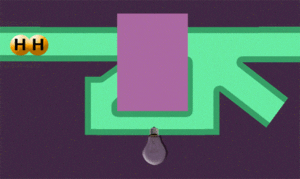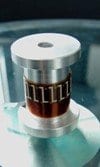
The technology “offers nearly miraculous potential.”
When a current passes between two electrodes — one thinner than the other — it creates a wind in the air between. If enough voltage is applied, the resulting wind can produce a thrust without the help of motors or fuel.
This phenomenon, called electrohydrodynamic thrust — or, more colloquially, “ionic wind” — was first identified in the 1960s. Since then, ionic wind has largely been limited to science-fair projects and basement experiments; hobbyists have posted hundreds of how-to videos on building “ionocrafts” — lightweight vehicles made of balsa wood, aluminum foil and wire — that lift off and hover with increased voltage.
Despite this wealth of hobbyist information, there have been few rigorous studies of ionic wind as a viable propulsion system. Some researchers have theorized that ionic thrusters, if used as jet propulsion, would be extremely inefficient, requiring massive amounts of electricity to produce enough thrust to propel a vehicle.
Now researchers at MIT have run their own experiments and found that ionic thrusters may be a far more efficient source of propulsion than conventional jet engines. In their experiments, they found that ionic wind produces 110 newtons of thrust per kilowatt, compared with a jet engine’s 2 newtons per kilowatt. The team has published its results in the Proceedings of the Royal Society.
Steven Barrett, an assistant professor of aeronautics and astronautics at MIT, envisions that ionic wind may be used as a propulsion system for small, lightweight aircraft. In addition to their relatively high efficiency, ionic thrusters are silent, and invisible in infrared, as they give off no heat — ideal traits, he says, for a surveillance vehicle.
“You could imagine all sorts of military or security benefits to having a silent propulsion system with no infrared signature,” says Barrett, who co-authored the paper with graduate student Kento Masuyama.
Shooting the gap
A basic ionic thruster consists of three parts: a very thin copper electrode, called an emitter; a thicker tube of aluminum, known as a collector; and the air gap in between. A lightweight frame typically supports the wires, which connect to an electrical power source. As voltage is applied, the field gradient strips away electrons from nearby air molecules. These newly ionized molecules are strongly repelled by the corona wire, and strongly attracted to the collector. As this cloud of ions moves toward the collector, it collides with surrounding neutral air molecules, pushing them along and creating a wind, or thrust.
To measure an ion thruster’s efficiency, Barrett and Masuyama built a similarly simple setup, and hung the contraption under a suspended digital scale. They applied tens of thousands of volts, creating enough current draw to power an incandescent light bulb. They altered the distance between the electrodes, and recorded the thrust as the device lifted off the ground. Barrett says that the device was most efficient at producing lower thrust — a desirable, albeit counterintuitive, result.
“It’s kind of surprising, but if you have a high-velocity jet, you leave in your wake a load of wasted kinetic energy,” Barrett explains. “So you want as low-velocity a jet as you can, while still producing enough thrust.” He adds that an ionic wind is a good way to produce a low-velocity jet over a large area.
The Latest Bing News on:
Ionic thrusters
- New space company seeks to solve orbital mobility with high delta-v spacecrafton April 30, 2024 at 6:31 am
But a new company, Portal Space Systems, emerged from stealth on Tuesday with an alternative: solar-thermal propulsion. The company's founder, Jeff Thornburg, said Portal Space will focus on mobility ...
- NASA Unveils Game-Changing Electric Propulsion Technology for Future Space Missionson April 29, 2024 at 12:42 pm
NASA's innovative propulsion technology propels small spacecraft exploration and extends satellite lifetimes, supporting U.S. leadership in space technology. NASA has developed an advanced propulsion ...
- Batteries Newson April 28, 2024 at 5:00 pm
Apr. 9, 2024 — An improved charging protocol might help lithium-ion batteries to last much longer. Charging with a high-frequency pulsed current reduces aging effects, an international team ...
- RocketStar Inc's Breakthrough in Space Travel: The Nuclear Fusion Driveon April 27, 2024 at 11:46 pm
In the realm of space exploration and satellite deployment, propulsion technology is the linchpin to achieving ever-greater milestones. Imagine a spacecraft that harnesses the power of nuclear fusion, ...
- Underwater robot pioneers new energy-efficient buoyancy controlon April 25, 2024 at 11:17 am
A remotely operated underwater robot built by a team of Rice University engineering students pioneers a new way to control buoyancy via water-splitting fuel cells. The device, designed and constructed ...
- China has reportedly made progress on a laser-powered submarine projecton April 25, 2024 at 5:51 am
Chinese scientists have achieved a groundbreaking advancement in submarine propulsion systems with the development of a laser-engineered, supersonic, and silent submarine.
- NASA’s new Hall-effect thruster could unlock small spacecraft revolutionon April 24, 2024 at 8:54 am
NASA’s new Hall-effect thruster. A Hall-effect thruster is a type of ion thruster that accelerates propellant using an electric field. The technology is already widely used in s ...
- First Look: Mercedes-Benz Geländewagen Goes All-Electricon April 23, 2024 at 7:30 pm
The two-tiered lithium-ion battery has 216 cells installed in 12 cell modules ... Double-universal-joint driveshafts transfer drive propulsion and incorporate slip joints to equalize the length.
- Former NASA engineer claims he invented a ground-breaking thruster that doesn’t need fuelon April 23, 2024 at 1:21 pm
That’s why projects like NASA’s SLS aren’t sustainable and why many have looked for ways to create propellant-free thrusters to help revolutionize how space travel works. Now, a former NASA ...
- Former NASA Engineer Says He's Invented a Thruster That Doesn't Require Propellanton April 22, 2024 at 11:35 am
Space startup Exodus Propulsion Technologies claims to have achieved a breakthrough, stumbling upon an entirely new force of nature that could power thrusters that don't need propellant to work.
The Latest Google Headlines on:
Ionic thrusters
[google_news title=”” keyword=”ionic thrusters” num_posts=”10″ blurb_length=”0″ show_thumb=”left”] [/vc_column_text]The Latest Bing News on:
Ionic wind
- Amazon results much better than expectedon April 30, 2024 at 3:05 pm
Business media got all excited about the quarterly results from Amazon, which were much better than expected. However, the outlook was weaker than expected for another quarter.
- Turmoil at Bapcor as CEO quitson April 30, 2024 at 12:09 am
In an ominous sign, shares in the auto products group Bapcor (ASX:BAP) were halted on Tuesday ahead of a trading update, which is expected to outline sliding sales and profits.
- The 30 best Walmart deals to shop this week — save up to 80% on Mother's Day gifts, gardening supplies and moreon April 26, 2024 at 2:23 pm
Some major deals on board: a Dyson stick vac for just $300, an HP laptop for $240 off and a powerful tower fan at a nearly 40%-plus markdown.
- Using sodium to develop rechargeable batteries may bolster the EU's green ambitionson April 25, 2024 at 10:41 am
A green industrial future for Europe may depend on an element that is part of a household staple: table salt. Dr. John Abou-Rjeily, a researcher at Tiamat Energy in France, is using sodium to develop ...
- Rare Earths Reserves: Top 8 Countries (Updated 2024)on April 24, 2024 at 1:55 pm
Rare earths prices soared to their highest level in 20 months, according to OilPrice.com, in early Q3 2023 coinciding with a temporary production halt in Myanmar, which accounted for 38 percent of ...
- 29 Mother's Day Gifts for 2024on April 24, 2024 at 6:47 am
Comfy slippers, tasty treats, and other sure-to-please ideasBy Mary Beth QuirkIf there’s anything moms need at any given time, it’s most likely a break. A quiet moment with a latte, a good show ...
- Ionic Rare Earths Limited: Raises $5.5 Million in a Placementon April 23, 2024 at 8:16 pm
The Board of Ionic Rare Earths Ltd. announces it has received firm commitments to raise $5.5 million by way of a share placement of approximately 423 million shares at $0.013 per share . The Placement ...
- Si6 to light up “Lithium Valley” with new Brazil drill blitzon April 18, 2024 at 1:04 am
Si6 Metals has detailed plans to kick off its third drilling program in Brazil’s renowned “Lithium Valley”, with 20 auger holes to be plunged as the company homes in on lithium and rare earths soil ...
- High Voltage: Aussie government throws graphite and HPA projects a tasty bone or twoon April 17, 2024 at 8:40 pm
Alpha HPA and Renascor receive a sugar daddy hug from Albo this week. Lithium's "spot" pricing trends… steadily. So that's okay, too.
- Flexible pseudocapacitor operates in extreme temperatures, stores high energyon April 15, 2024 at 5:00 pm
By buffering the intermittent output of wind and solar farms, they could help accelerate the ... Organic electrolytes widen the voltage range but introduce flammability risks. Ionic liquids are ...
The Latest Google Headlines on:
Ionic wind
[google_news title=”” keyword=”ionic wind” num_posts=”10″ blurb_length=”0″ show_thumb=”left”]









